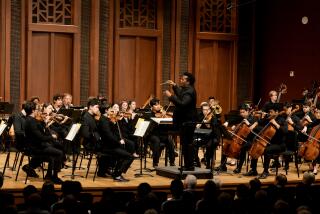Sonny Rollins -- a survivor and more
- Share via
You can say one thing about Sonny Rollins: He has an impressive work ethic. His performance Wednesday at Walt Disney Concert Hall was a more than 90-minute jazz extravaganza, propulsively driven by his tenor saxophone soloing.
Rollins, 74, is one of the few survivors of jazz’s explosively creative era of the ‘50s and ‘60s who’s still active. He was (with John Coltrane) one of the two principal architects of post World War II jazz tenor saxophone playing, a powerful participant in the hard bop of the ‘50s, an incisive improvisational adventurer in his influential work of the ‘60s.
In a performance at UCLA’s Royce Hall three years ago, however, Rollins’ playing was only a dim echo of his youthful years, his dark, magisterial tone replaced by a thin sound and a quavery vibrato. All of which created some apprehension before Wednesday night’s performance.
As it turned out, Rollins was in fine form, not simply in terms of his strength and endurance, but in terms of his musical imagination, as well.
His program relied on three stylistic areas: hard-swinging mid-tempo numbers, ballads and Caribbean rhythms typical of his hit tune “St. Thomas” (which, curiously, he chose not to play). Rollins was at his best in the ballads -- especially “They Say It’s Wonderful” and “A Nightingale Sang in Berkeley Square.”
His improvisational method has always employed melodic paraphrase, especially in slower numbers. And although he did not achieve the off-center, chromatically daring paraphrases of his youth, he clearly illustrated the attractions of a style too rarely explored by contemporary players.
Both the faster numbers and the calypso rhythm tunes fared less well. Rollins once used riffs and melodic fragments as building blocks for stunning improvisational architecture. On this evening, they were simply the substantive elements in his soloing, attractive in a collective sense, but rarely coming together into a larger, cohesive perspective.
Rollins was served well by a competent backup group -- trombonist Clifton Anderson, bassist Bob Cranshaw, guitarist Bobby Broom, drummer Steve Jordan and percussionist Kimati Dinizulu.
But the spotlight, appropriately, was his in a performance that, for its occasional flaws, afforded an opportunity to hear one of jazz’s great veteran artists in action.
More to Read
The biggest entertainment stories
Get our big stories about Hollywood, film, television, music, arts, culture and more right in your inbox as soon as they publish.
You may occasionally receive promotional content from the Los Angeles Times.









